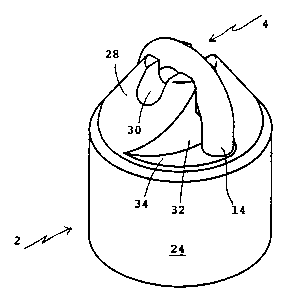Some of the information on this Web page has been provided by external sources. The Government of Canada is not responsible for the accuracy, reliability or currency of the information supplied by external sources. Users wishing to rely upon this information should consult directly with the source of the information. Content provided by external sources is not subject to official languages, privacy and accessibility requirements.
Any discrepancies in the text and image of the Claims and Abstract are due to differing posting times. Text of the Claims and Abstract are posted:
| (12) Patent: | (11) CA 2143303 |
|---|---|
| (54) English Title: | PADLOCKS |
| (54) French Title: | CADENAS |
| Status: | Expired and beyond the Period of Reversal |
| (51) International Patent Classification (IPC): |
|
|---|---|
| (72) Inventors : |
|
| (73) Owners : |
|
| (71) Applicants : |
|
| (74) Agent: | GOWLING WLG (CANADA) LLP |
| (74) Associate agent: | |
| (45) Issued: | 2004-10-12 |
| (86) PCT Filing Date: | 1993-08-18 |
| (87) Open to Public Inspection: | 1994-03-03 |
| Examination requested: | 2000-06-07 |
| Availability of licence: | N/A |
| Dedicated to the Public: | N/A |
| (25) Language of filing: | English |
| Patent Cooperation Treaty (PCT): | Yes |
|---|---|
| (86) PCT Filing Number: | PCT/AU1993/000421 |
| (87) International Publication Number: | WO 1994004781 |
| (85) National Entry: | 1995-02-24 |
| (30) Application Priority Data: | ||||||
|---|---|---|---|---|---|---|
|
A padlock has a rotatable outer body part (24) which prevents the application
of torque from a wrench to force the shackle
(4) open. One or both ends of the padlock are also configured to prevent
application of a wrench, the configuration being generally
conical configuration (28) preferably at least at the shackle end (4) of the
body of the padlock.
Note: Claims are shown in the official language in which they were submitted.
Note: Descriptions are shown in the official language in which they were submitted.

2024-08-01:As part of the Next Generation Patents (NGP) transition, the Canadian Patents Database (CPD) now contains a more detailed Event History, which replicates the Event Log of our new back-office solution.
Please note that "Inactive:" events refers to events no longer in use in our new back-office solution.
For a clearer understanding of the status of the application/patent presented on this page, the site Disclaimer , as well as the definitions for Patent , Event History , Maintenance Fee and Payment History should be consulted.
| Description | Date |
|---|---|
| Time Limit for Reversal Expired | 2007-08-20 |
| Letter Sent | 2006-08-18 |
| Inactive: IPC from MCD | 2006-03-11 |
| Inactive: IPC from MCD | 2006-03-11 |
| Inactive: IPC from MCD | 2006-03-11 |
| Inactive: Late MF processed | 2005-08-24 |
| Letter Sent | 2005-08-18 |
| Grant by Issuance | 2004-10-12 |
| Inactive: Cover page published | 2004-10-11 |
| Pre-grant | 2004-07-14 |
| Inactive: Final fee received | 2004-07-14 |
| Notice of Allowance is Issued | 2004-06-16 |
| Notice of Allowance is Issued | 2004-06-16 |
| Letter Sent | 2004-06-16 |
| Inactive: Approved for allowance (AFA) | 2004-06-08 |
| Letter Sent | 2004-05-13 |
| Amendment Received - Voluntary Amendment | 2004-04-29 |
| Reinstatement Requirements Deemed Compliant for All Abandonment Reasons | 2004-04-29 |
| Reinstatement Request Received | 2004-04-29 |
| Inactive: Abandoned - No reply to s.30(2) Rules requisition | 2003-12-16 |
| Inactive: S.30(2) Rules - Examiner requisition | 2003-06-16 |
| Amendment Received - Voluntary Amendment | 2000-09-29 |
| Letter Sent | 2000-07-19 |
| Inactive: Status info is complete as of Log entry date | 2000-07-18 |
| Inactive: Application prosecuted on TS as of Log entry date | 2000-07-18 |
| Request for Examination Requirements Determined Compliant | 2000-06-07 |
| All Requirements for Examination Determined Compliant | 2000-06-07 |
| Application Published (Open to Public Inspection) | 1994-03-03 |
| Abandonment Date | Reason | Reinstatement Date |
|---|---|---|
| 2004-04-29 |
The last payment was received on
Note : If the full payment has not been received on or before the date indicated, a further fee may be required which may be one of the following
Please refer to the CIPO Patent Fees web page to see all current fee amounts.
| Fee Type | Anniversary Year | Due Date | Paid Date |
|---|---|---|---|
| MF (application, 4th anniv.) - standard | 04 | 1997-08-18 | 1997-08-06 |
| MF (application, 5th anniv.) - standard | 05 | 1998-08-18 | 1998-08-18 |
| Registration of a document | 1999-02-16 | ||
| MF (application, 6th anniv.) - standard | 06 | 1999-08-18 | 1999-08-09 |
| Request for examination - standard | 2000-06-07 | ||
| MF (application, 7th anniv.) - standard | 07 | 2000-08-18 | 2000-08-14 |
| MF (application, 8th anniv.) - standard | 08 | 2001-08-20 | 2001-08-02 |
| MF (application, 9th anniv.) - standard | 09 | 2002-08-19 | 2002-07-25 |
| MF (application, 10th anniv.) - standard | 10 | 2003-08-18 | 2003-07-17 |
| Reinstatement | 2004-04-29 | ||
| Final fee - standard | 2004-07-14 | ||
| MF (application, 11th anniv.) - standard | 11 | 2004-08-18 | 2004-07-20 |
| Reversal of deemed expiry | 2005-08-18 | 2005-08-24 | |
| MF (patent, 12th anniv.) - standard | 2005-08-18 | 2005-08-24 | |
| MF (application, 2nd anniv.) - standard | 02 | 1995-08-18 |
Note: Records showing the ownership history in alphabetical order.
| Current Owners on Record |
|---|
| R.P.L. INDUSTRIES (INTERNATIONAL) PTY. LTD. |
| R.P.L. INDUSTRIES PTY. LTD. |
| Past Owners on Record |
|---|
| RUSSELL PHILLIP LONG |